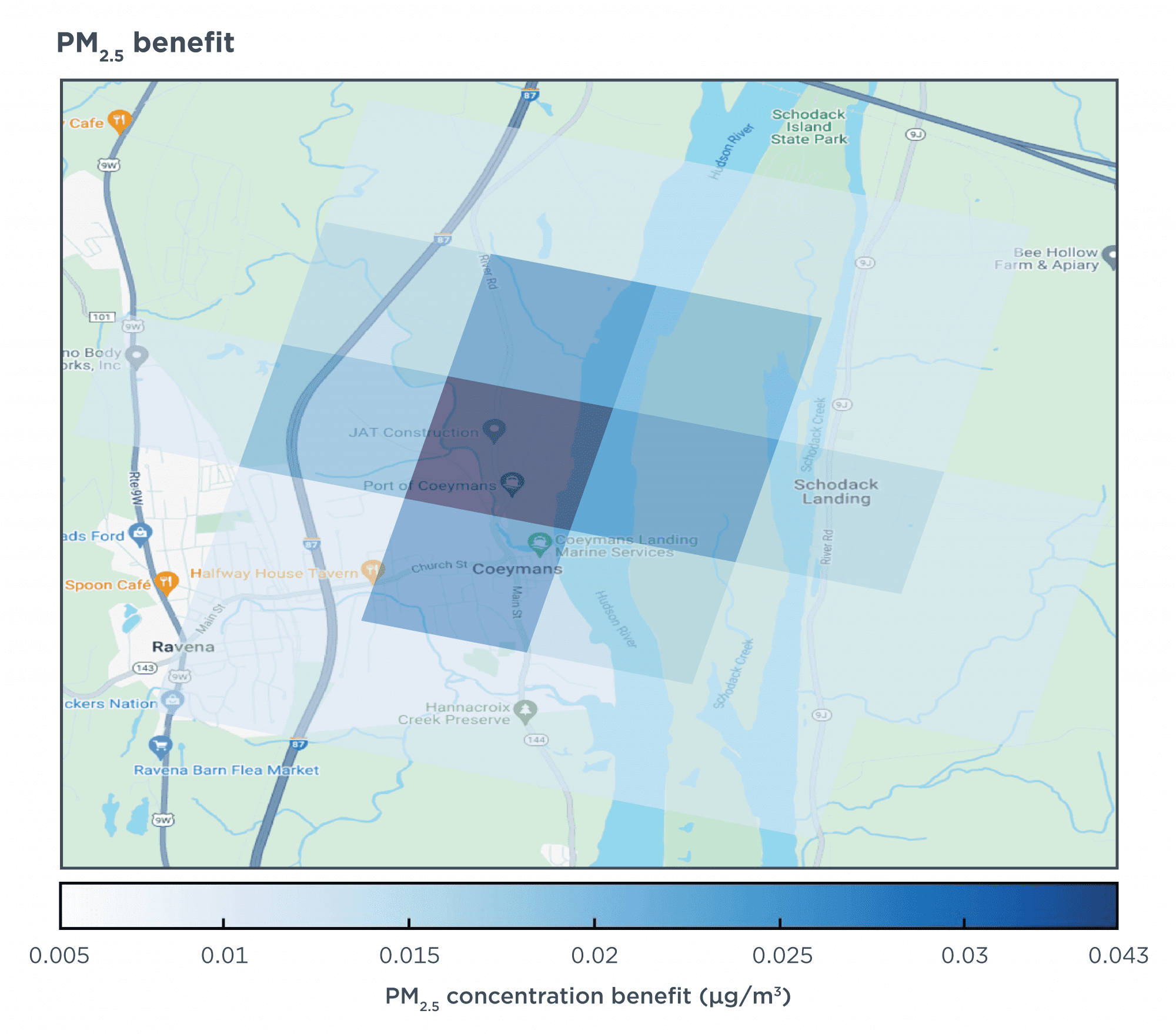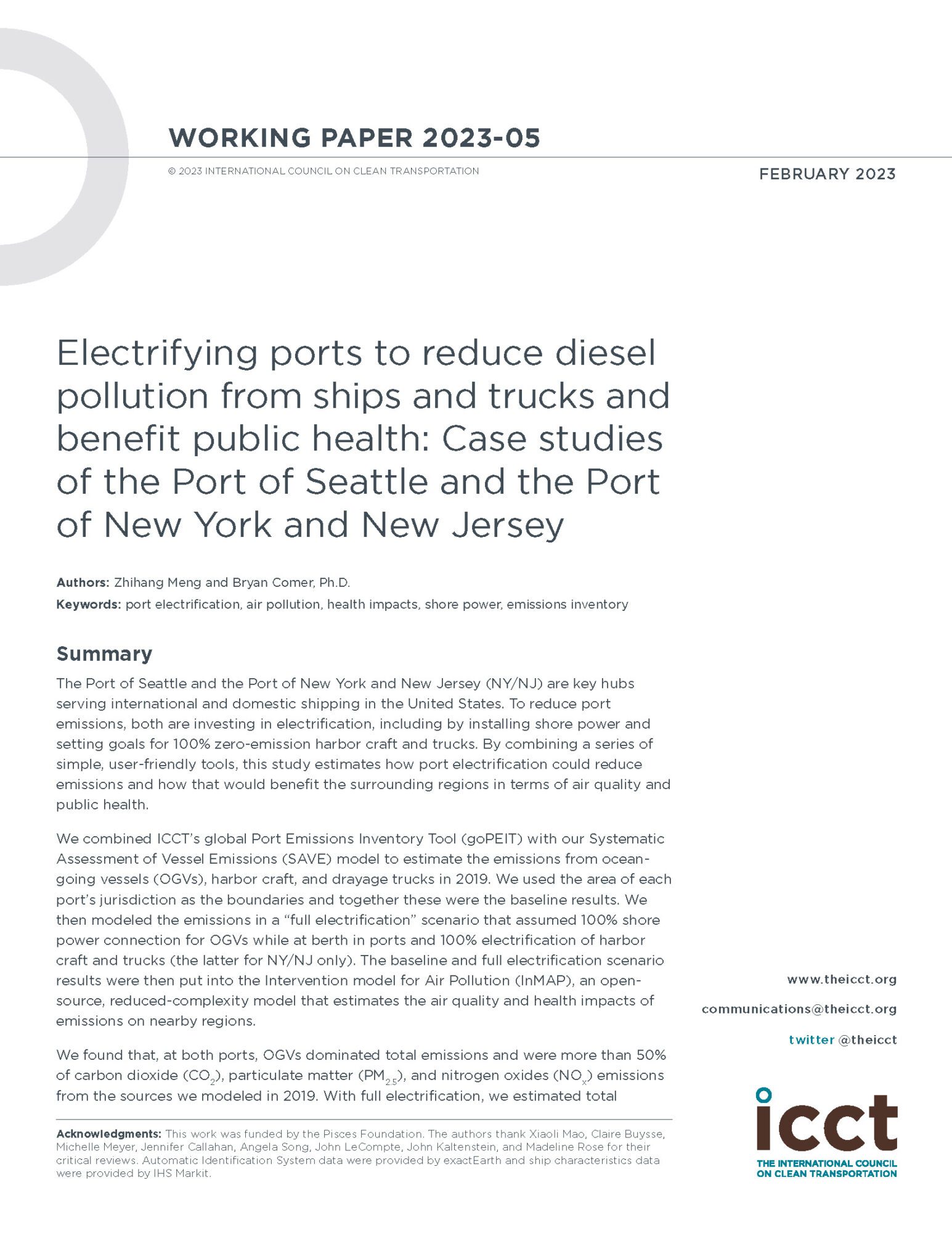Blog
How U.S. ports can partner with the ICCT to leverage federal funding for electrification
A recent report from the U.S. Environmental Protection Agency (EPA) found that most U.S. ports lack an air quality monitoring program, and even fewer have emission inventories. Although ports would benefit from both, and EPA has some helpful guidance on conducting emission inventories, these types of analyses require specialized skills and resources, including equipment and expertise.
This is where we come in. With technical assistance from the ICCT, ports can identify high-emitting equipment and estimate the benefits of electrification. Let’s walk through how we work using a recent example.
The ICCT partnered with the Port of Coeymans, a small, privately owned marine terminal on the Hudson River near Albany, New York. Its fleet consists of nine diesel-powered tugs and more than 40 barges. The Port, which is under the umbrella of Carver Companies, has capacity for heavy haul transport of large components, modularization of power plants and bridges, marine construction, disaster recovery projects, and has recently pivoted toward supporting offshore wind projects. Carver Companies is equipped to build and repair ships on-site, including electric tugboats. We estimated the emission reductions and health benefits of converting to an all-battery-electric tug fleet.
The port sent us the specifications of the nine tugs and officials estimated that they burned roughly 120,000 gallons of 500 ppm sulfur marine diesel fuel annually. Using our global online Port Emissions Inventory Tool (goPEIT), we estimated the annual carbon dioxide (CO2) and air pollutant emissions from tug operations. We then used InMAP to estimate the reduction in local air pollution and the health benefits associated with the switch to battery electric tugs. Lastly, we calculated the monetized health benefits of the switch using EPA’s value of a statistical life.
Our estimates show that the nine tugs at the Port of Coeymans emitted around 1,200 MT of CO2, 20 MT of nitrogen oxides (NOx), 380 kg of sulfur oxides (SOx), and 320 kg of fine particulate matter (PM2.5) annually. If all nine tugs were battery electric, these emissions would be eliminated and annual average local PM2.5 air pollution concentrations in and around the port would be reduced by up to 0.043 µg/m3 (Figure 1). This would be a 1.1% reduction in PM2.5, based on the real-world PM2.5 background concentrations reported here. The 30-day average when we completed the analysis in March/April 2024 was 3.8 µg/m3.

The reduction in PM2.5 would result in monetized health benefits of approximately $278,000 per year based on the 2022 mean U.S. value of a statistical life. One air-pollution-related premature death in the surrounding community would be avoided every 41 years; this might not sound like much, but this is the impact of one single action at a small port in a town with a population of approximately 7,250. Monetized health benefits of avoided morbidity (non-fatal health effects) are not quantified by InMAP, but global estimates of the economic impacts of air pollution suggest that morbidity cost is roughly 10% of mortality cost. Thus, in this case, including avoided morbidity in our estimate could increase the monetized health benefits to more than $300,000 annually.
The Port of Coeymans included our analysis in applications for federal funding, and similar analyses can be done for other ports, including those with larger fleets, more equipment types, and higher nearby population density. Ports around the country are increasingly interested in electrification as it can reduce pollution, improve public health, and help decarbonize the U.S. freight transportation system. But of course, this requires investment. Fortunately, recent legislation, including the Bipartisan Infrastructure Law (BIL) of 2021 and the Inflation Reduction Act (IRA) of 2022, have made available more than $5 billion to support efforts to reduce pollution at U.S. ports.
EPA’s Clean Ports Program (CPP) was funded through the IRA and made $3 billion available, $750 million of which was for ports in areas that do not meet the EPA National Ambient Air Quality Standards. This was a one-time funding opportunity and applications closed in late May, but ports can still apply for funding through the U.S. Maritime Administration’s Port Infrastructure Development Program (PIDP). The PIDP is a discretionary grant program aimed at improving the movement of goods at ports and implementing emissions-mitigation measures. It was awarded $2.25 billion from 2022 to 2026 through the BIL and a quarter of this is designated for projects at small ports.
A larger network of ports in the United States with air quality monitoring programs would make it easier to identify key areas where federal funding can most effectively be distributed. Strategic installation of port electrification technology can improve the air quality for near-port communities, many of which are lower-income and have historically been affected by poor air quality from port activity.
An upcoming ICCT report will estimate the CO2, NOx, SOx, and PM emissions from at-berth vessels at 191 ports across the United States. As far as we’re aware, it’s the first high-level national port emissions inventory of its kind. Using novel criteria, we identified seven ports with high at-berth vessel emissions near a large population that could benefit significantly from installing shore power or other vessel-side electrification technologies.
Our work is ongoing. No matter how big or small the port or the surrounding population, more ports should consider implementing an air quality monitoring program and conducting an emissions inventory. We encourage port officials who are interested in learning more about collaborating with the ICCT on an analysis like the one with the Port of Coeymans to contact us through our website.
Authors
Related Publications

Combines user-friendly, reduced-complexity tools to estimate the emissions reduction potential and health benefits of electrifying ocean-going vessels, harbor craft, and drayage trucks at two of the United States’ busiest ports.



